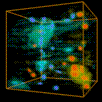Quasi-Geostrophic Turbulence

Abstract
Large parts of the Earth's Atmosphere and Ocean have a
gravitationally stable density stratification, with lighter fluid
above heavier fluid. This stable stratification, combined with the
planetary rotation, causes the most energetic motion to occur
approximately in horizontal planes. For this situation we solve an
approximate set of equations, called the Quasi-Geostrophic equations,
using a fully implicit multigrid algorithm. In solutions for the decay
from random initial conditions, we see the spontaneous emergence of
concentrated vortices that regulate the evolution of the flow. The
inclusion of the "beta effect", i.e., the variation in the Coriolis
force with latitude due the Earth's sphericity, introduces Rossby
waves and jets which compete with the vortices.
Project Description
The discovery of "coherent structures" in turbulent fluid flow has
certainly been one of the most prominent advances in the field of
fluid mechanics in the last 25 years. A "coherent structure" may be
thought of as a shape or form in a turbulent fluid flow that persists
a long time relative to it's own period of internal circulation. One
example of a "coherent structure" is the Great Red Spot of Jupiter's
atmosphere, a long-term stable pattern in the chaotic and energetic
flow of the Jovian atmosphere.
The primary goal of this project is to calculate fluid turbulence
under the influences of environmental rotation and variable density at
unprecedentedly high resolution by using the largest, hence newest,
available computers. The guiding hypothesis is that this will provide
a superior depiction of fully developed turbulence and thus provide
new insights into its fundamental nature.
As part of this project, new codes have been developed to calculate
fluid motions under the approximation of incompressibility. This is
appropriate for slow motions (with small Mach number), such as those
that occur on large scales in the earth's atmosphere and ocean, as
well as in laboratory fluid tanks. These codes are currently being run
on the Cray C-90 computer at the Pittsburgh Supercomputing Center, and
are being ported to the Cray T3D.
I. f-Plane
Below are images of the potential vorticity field for a computation on
an "f-plane", i.e. rotation with constant Coriolis parameter, at a
resolution of 320^3. One sees that starting from random initial
conditions, the fluid self-organizes into coherent vortices. These
vortices subsequently advect each other, merge to form larger
vortices, and align vertically.
Still Images
Animations
- Vortex Advection Movie, 218 KB
An animation calculated at a resolution of 256^3 with high
temporal resolution showing the mutual advection of vortices.
- Vortex Evolution Movie,796 KB
An animation calculated at a resolution of 256^3 with relatively low
temporal resolution covering the entire computation showing the vortex
evolution.
Another
web page about these computations can be found at NCAR.
II. Beta-Plane
Below are images of the potential vorticity field from a simulation
on the "beta-plane", i.e. with linear latitudinal variation in the
Coriolis parameter, at a resolution of 256^3. The coherent vortices
now grow through merger and alignment until they reach the scale where
the beta-effect becomes important, at which point dispersive Rossby
waves are excited, destroying the vortices and producing horizontal
jets.
References